Amanda Cachia
WHAT CAN A BODY DO?
Opening on October 26, 2012 at Cantor Fitzgerald Gallery at Haverford College in Pennsylvania, What Can a Body Do? is an exhibition that narrows the question originally posed by French philosopher Gilles Deleuze into: "what can a disabled body do?" In my introduction my introduction for the catalogue essay, What Can a Body Do?" I write: "Further, this exhibition asks, what does it mean to inscribe a contemporary work of art with experiences of disability? What shapes or forms can these inscriptions take? How, precisely, can perceptions of the disabled body be liberated from binary classifications such as "normal" versus "deviant" or "ability" versus "disability" that themselves delimit bodies and constrain action? What alternative frameworks can be employed by scholars, curators, and artists in order to determine a new fate for the often stigmatized disabled identity?"1
I continue in the catalogue essay, "In "What Can a Body Do?" Deleuze draws from two statements by seventeenth-century Dutch philosopher Baruch de Spinoza: 'We do not even know what a body is capable of' and 'We do not even know of what affections we are capable, nor the extent of our power.'2 In other words, we haven't even begun to understand the potential of our bodies! Most of us know even less about the disabled body. It is important to think about what disability does rather than simply what it is. Such reframing breaks binary constructs as it is focused on a type of concretized being-in-the-world, on the truths of living inside a disabled body. As disability bioethicist Jackie Leach Scully argues, 'understanding the experience of disability from this inside is essential to inform ethical judgments about impairment.'3 Asking what the disabled body can do helps us to understand what it means to think and be through the variant body. To use a term originally developed by Michel Foucault to describe knowledge and ways of knowing that are left out, the disabled experience has been a subjugated knowledge.4 But what if disability could become an epistemic resource and an embodied cognition embedded with politicized consciousness? Or, more simply, a way of knowing the world?"
For this exhibition, nine contemporary artists, including Joseph Grigely, Christine Sun Kim, Park McArthur, Alison O'Daniel, Carmen Papalia, Laura Swanson, Chun-Shan (Sandie) Yi, Corban Walker and Artur Zmijewski demonstrate new possibilities across a range of media by exploring bodily configurations in figurative and abstract forms. The artists invent and reframe disability, each time anew. They challenge entrenched views of d isability, both positive and negative, and show that we do not yet know what bodies are, nor what bodies – all bodies – can or should do. Their work confronts dominant cultural perception of scale, deafness, blindness, mobility, visible and invisible body differences, as well as the negative characteristics often attributed to disabled people. These nine artists adjust and destabilize an often reductive representation of the disabled body to move toward more complex concepts of embodiment. They radically open up our expectations for encounters with the physical world and demonstrate that various subject positions can be ruptured and replaced by a complex embodiment that includes impairment as a means for illumination. They use a blend of representational and non-representational imagery, immersive environments, two-dimensional and three-dimensional objects and sculptures, performances and social practice to explore non-standard perceptual and sensory experiences. They create mixed, hybridized and invented senses – even a new language.
The artists foreground new possibilities such as how to experience music based on physical gestures and movement in imagery through the work of Joseph Grigely, Christine Sun Kim and Alison O'Daniel, or how sound can provide a new entry-point for a walk through an urban environment in Carmen Papalia's installation.
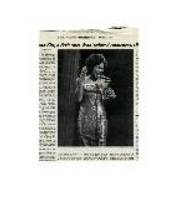
Joseph Grigely
Song Without Words,
2009 Pigment Prints
40" x 35"

Christine Sun Kim
Seismic Calligraphy, 2009
Ink and powder-drenched
quills on paper
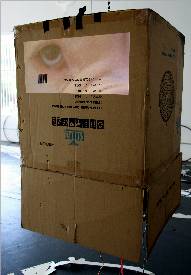
Alison O'Daniel
God's Eye, 2011
Mixed Media
Park McArthur's New York City care collective complicates notions of capacity and ability in the intermingling of bodies playing roles of carer and caree.
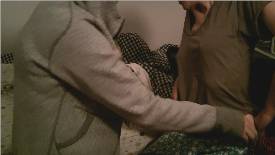
Park MacArthur
It's Sorta Like a Big Hug, 2012
Pigment Prints
40" x 35"
Laura Swanson and Corban Walker both destabilize common notions of scale and prejudicial associations regarding height and size by offering alternative enclosures for the dwarf embodiment.

Corban Walker
TV Man 2010
LCD monitor 65", computer and video file
61-1/8" x 36-3/8" x 4"
In Chun-Shan (Sandie) Yi's work, the artist challenges notion of a "complete" body by suggesting that the body can reinvent itself through new footwear and "disability fashion," while Zmijewski's inter-twined male bodies, one an amputee and the other a non-amputee, transform definitions for support and insufficiency.
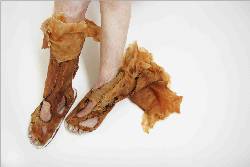
Chun-Shan (Sandie) Yi
Dermis Leather Footwear, 2009
Digital chromogenic print
10" x 30"
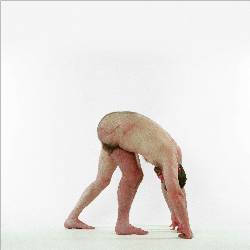
Artur Zmijewski
An Eye for An eye 1998
Photo on dibond board
100 x 100 cm
Within these possibilities, the artists maintain an authority and ownership over their bodies and their bodies' experiences that re-arrange, re-order and help us re-think what the body can do. There is also a push for a broader politics of disabled identity.5
What Can a Body Do? is the second exhibition I have curated that is based on the theme of disability. In fall, 2011, I curated Medusa's Mirror: Fears, Spells and Other Transfixed Positions for Pro Arts Gallery in Oakland that included several of the artists also featured in What Can a Body Do? namely Joseph Grigely, Carmen Papalia, Laura Swanson and Chun-Shan (Sandie) Yi. Other artists were Neil Marcus, Katherine Sherwood, Sunaura Taylor and Sadie Wilcox. This exhibition focused on the shifting position of the disabled subject in visual culture, from a body that is invisible, to a body that becomes visible, reflecting a mirror back onto society to challenge essentialist notions of the disabled subject. The disabled subject is thus no longer the victim of the able-bodied gaze. In Greek mythology Medusa was viewed as a monster, and gazing directly upon her would turn onlookers to stone. In many ways, the disabled subject has similar stereotypical qualities to Medusa – that of being monstrous, and transfixing viewers, either with fear, curiosity or wonder. This exhibition's agenda was to shift Medusa's position, and thus make unstable the disabled subject as agent and causer of fear, spells and transfixed positions. I was hoping that what viewers would learn from the work is that the disabled body is anything but transfixed.
In both of these exhibitions, I aimed and aim to complicate and deepen our notion of "access" in a museum and gallery space. To many, providing access simply means modifying a physical space. As Kristin Lindgren and Debora Sherman write in the foreword to the exhibition catalogue for What Can A Body Do?: "To those who are more informed, access also means making information available in multiple modes, hiring ASL interpreters, using technology creatively, providing texts in large print and alternative formats, and so on. But once we begin to imagine what full access might look like, the possibilities seem endless, the concept elusive and protean. Access involves more than checking off a list of practical accommodations. It is a way of thinking about the world that challenges us to imagine how another body, another self, experiences it. What could be more intellectually engaging than imagining another's world? Isn't this something like what we do when we read a novel? Why are we so reluctant to imagine the different bodies and different lives of the nonfictional people with whom we live and work?"
Addressing this particular exhibition, Lindgren and Sherman continue: "By hanging the work at variable heights and providing audio description from multiple perspectives, I ask the viewer to pay attention to the conventions of how we display and describe works of art and how we move through a gallery or experience a performance. Access is treated not as an afterthought but as a creative process intrinsic both to art practice and curatorial practice. The gallery staff, the curator, and the artists have worked together to place access front and center, going well beyond ADA standards and current museum and gallery protocols. Together, they challenge us to rethink the ways in which meaning is made across a broad spectrum of human subjects, and in so doing, fundamentally extend what it means to be human."6
I conclude my essay in the exhibition catalogue by saying: "Collectively, the artists in What Can a Body Do? expand our understanding and offer new possibilities of what constitutes a representable body through their powerful multi-sensorial art practices, and with this, they also expand our thinking about disability itself."7 The exhibition will remain on display at Cantor Fitzgerald Gallery until December 16, 2012.
Works Cited
1. Amanda Cachia, "What Can a Body Do?" in What Can a Body Do? curated by Amanda Cachia (Pennsylvania: Haverford College, 2012), 5-23.
2. Gilles Deleuze, "What Can a Body Do?," in Expressionism in Philosophy: Spinoza (New York: Zone Books, 1990), 226.
3. Jackie Leach Scully, "Thinking Through the Variant Body," in Disability Bioethics: Moral bodies, Moral difference (London: Rowman and Littlefield Publishers, 2008), 84.
4. For Foucault's discussion of subjugated knowledges, see, The Order of Things: An Archaeology of the Human Sciences (New York: Vintage, 1994).
5. Amanda Cachia, "What Can a Body Do?" in What Can a Body Do? curated by Amanda Cachia (Pennsylvania: Haverford College, 2012), 5-23.
6. Kristen Lindgren and Debora Sherman, "Foreword" in What Can a Body Do? curated by Amanda Cachia (Pennsylvania: Haverford College, 2012), 3-4.
7. Amanda Cachia, "What Can a Body Do?" in What Can a Body Do? curated by Amanda Cachia (Pennsylvania: Haverford College, 2012), 5-23.